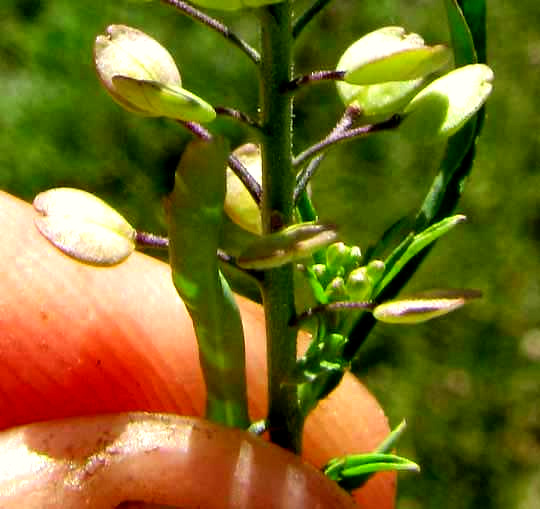Excerpts from Jim Conrad's
Naturalist Newsletter
from the March 20, 2011 Newsletter issued from Hacienda Chichen Resort beside Chichén Itzá Ruins, central Yucatán, MÉXICO; limestone bedrock, elevation ~39m (~128ft), ~N20.676°, ~W88.569°
POORMAN'S-PEPPER
Wandering the colorful and friendly backstreets of the nearby little Maya town of Xcalacoop I spotted an old friend from up North. You can see who I mean below:

A close-up of its flat, round, notched fruits is shown below:

As a kid dreaming of becoming a naturalist this was one of the first plants I learned, because it was such a common, easily recognizable, interesting weed. Recognizable because of those long racemes of small, flat, round fruits technically known as silicles, a special term used for short fruits of certain Mustard Family species. By "short" is meant a fruit not more than twice as long as wide. A long mustard fruit is known as a silique.
Anyway, back in Kentucky I learned to call the plant in the picture Poorman's Pepper, but it goes by many names in many languages. Among its other English names are Peppergrass, Pepperweed, Peppercress, Virginia Cress and more. It's LEPIDIUM VIRGINICUM of the Mustard Family.
The reason the word pepper appears so frequently in its names is that the flattish, round silicles have a biting, peppery taste. I've harvested the fruits in their green stage and added them to lettuce and tomato salads, and actually they tasted pretty good. However, it's time consuming to collect the fruits, and separate them from their stiff, fibrous stems, or pedicels. Also, unless you crunch a fruit between your teeth its pepperiness never is tasted, so either you must add a lot to a salad, or chew fastidiously.
I'd always assumed that Pepperweed, so common in dry, weedy areas, was an introduced European weed, and in fact I've seen it growing very robustly in Europe as well as Africa and tropical Asia. But upon reading about it for this entry I'm surprised to find that it's a native American species, apparently native as well to the Yucatán and through Central America. It's been introduced as a weed, though, in most of the rest of the world.